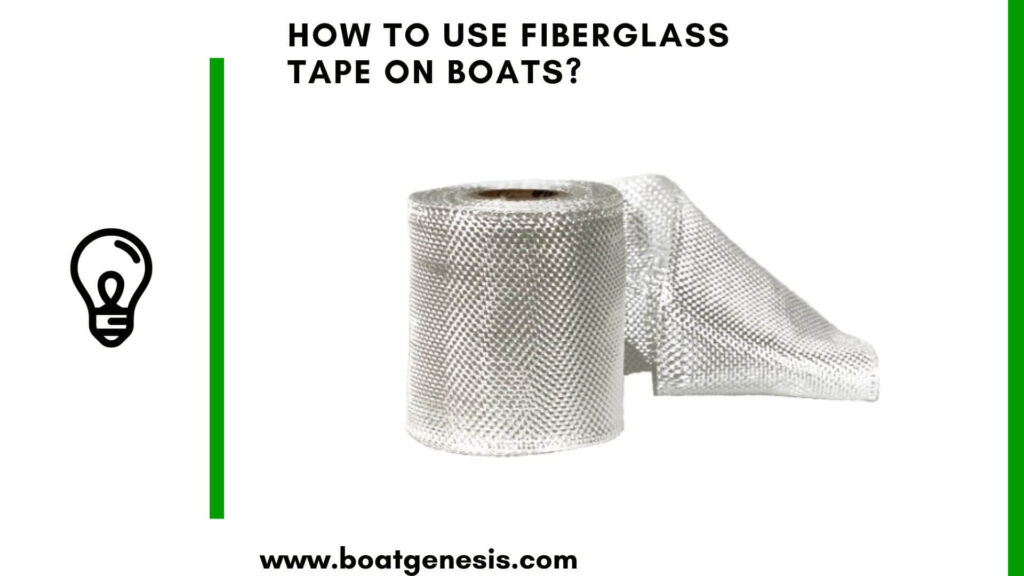Boats often endure wear and tear, resulting in scratches or minor damage to their fiberglass gel coat. One effective solution for addressing such issues involves using fiberglass repair tape.
This guide aims to elucidate the step-by-step process of effectively using fiberglass tape to maintain and protect your boat’s exterior.
Why Use Fiberglass Tape on Boats?
Fiberglass tape offers an easy patch solution for small holes, gaps, stress cracks, scrapes, and scratches on your boat’s exterior gelcoat. It creates a seamless bond over damaged areas to provide long-lasting waterproof repairs.
Fiberglass tape conforms well to curved surfaces, works with epoxy or polyester resins, and sands smoothly after curing.
Compared to hauling your boat for professional repairs, fixing fiberglass with speciality tape saves you money and time.
Step-by-Step Guide for Using Fiberglass Tape on Boats
Repairing fiberglass damage involves cleaning, applying adhesive filler, adding layers of tape, saturating with resin, and sanding once cured. Follow these key steps:
Step 1: Surface Preparation
Begin by cleaning the damaged area thoroughly, removing loose gelcoat chips, dirt, grease, wax, and any mold release agents. Ensure the surface is completely dry before proceeding to the next step.
Step 2: Cut and Apply Fiberglass Tape
Cut the fiberglass tape to cover the damaged area, allowing for a 2-inch overlap on all sides. Remove the paper backing from the tape. Gently press the tape onto the damaged area, ensuring it adheres properly.
Step 3: Resin Application
Prepare the polyester resin according to the manufacturer’s instructions. Use a disposable brush to apply the resin generously over the fiberglass tape. Ensure the tape is fully saturated with resin, creating a strong bond with the damaged surface.
Step 4: Layering (if necessary)
For larger damaged areas, apply additional layers of fiberglass tape following the same process of resin application. Ensure each layer is properly saturated and smoothly applied before adding the next layer.
Step 5: Finalizing the Application
Once the desired layers are in place, ensure the final layer is thoroughly saturated with resin until the tape’s cloth weave is no longer visible. This step ensures a sturdy and durable repair.
Step 6: Allow for Curing
Allow the applied fiberglass tape and resin to cure properly. Follow the manufacturer’s recommendations regarding curing time. This is crucial for ensuring the effectiveness of the repair.
Step 7: Finishing Touches
After the repair has fully cured, use sandpaper with a grit of 80-150 to sand the repaired area gently. This step aims to achieve a smooth finish that seamlessly blends with the surrounding gel coat.
Top Fiberglass Tape Tips
- Cut tape larger than the damaged area so it adheres adequately
- Apply thin coats of resin and saturate layers fully
- Tack tape in place with thickened resin before saturating
- Overlap and feather out the edges of the tape for invisible transitions
How can Fiberglass Tape and Resin Work Together to Restore Boat Gelcoat?
Fiberglass tape can be effectively used in conjunction with resin to repair small cracks, scratches, and minor damages on a boat’s gel coat.
The combination of fiberglass tape and resin forms a strong and durable patch over damaged areas, providing structural reinforcement and waterproofing.
Here’s how it typically works:
- Tape as a Reinforcement: Fiberglass tape acts as a reinforcement material. When applied over a damaged area, it provides additional strength and support, preventing further spreading of cracks or damage.
- Resin as an Adhesive: Resin, when applied along with fiberglass tape, serves as an adhesive that bonds the tape to the damaged surface. This creates a cohesive and solid repair that restores the integrity of the boat’s structure.
- Creating a Seamless Repair: The combination of the tape and resin creates a seamless bond that not only reinforces the damaged area but also ensures that the repair blends in with the surrounding gelcoat for a smooth finish.
The process involves cleaning the damaged area, applying the fiberglass tape to cover the affected part, and then saturating the tape with resin. The resin-soaked tape adheres to the surface, forming a robust repair once it cures.
This method is particularly effective for small-scale damages. However, for larger or more extensive repairs, it might be necessary to consult a professional for a comprehensive assessment and repair.
Or you could simply use other regular methods like the ones listed in this article:
==>> How to repair a fiberglass boat yourself?
Final Word
This article was all about how to use fiberglass tape on boats.
By following these simple yet precise steps, you can effectively use fiberglass tape to address minor damages on your boat’s gelcoat.
With attention to detail and proper application, you’ll restore your boat’s appearance and ensure its durability, saving both time and money in professional repairs.
Remember, the key to successful fiberglass tape application lies in meticulous surface preparation, proper resin application, and allowing adequate curing time for a robust and long-lasting repair.
With a little time and effort, you’ll have your watercraft looking shipshape again.


